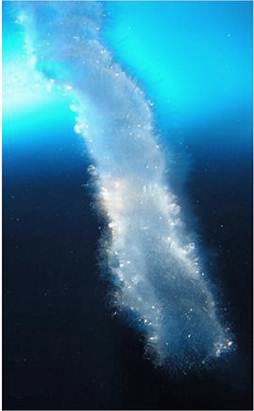FOR IMMEDIATE RELEASE | A PressPac Instant Replay*
ACS News Service Weekly PressPac: May 22, 2013
Ice tubes in polar seas - 'brinicles' or 'sea stalactites' - provide clues to origin of life
Life on Earth may have originated not in warm tropical seas, but with weird tubes of ice — sometimes called “sea stalactites” — that grow downward into cold seawater near the Earth's poles, scientists are reporting. Their article on these “brinicles” appears in ACS’ journal Langmuir.
Bruno Escribano and colleagues explain that scientists know surprisingly little about brinicles, which are hollow tubes of ice that can grow to several yards in length around streamers of cold seawater under pack ice. That’s because brinicles are difficult to study. The scientists set out to gather more information on the topic with an analysis of the growth process of brinicles.
They are shown to be analogous to a “chemical garden,” a standby demonstration in chemistry classes and children's chemistry sets, in which tubes grow upward from metal salts dropped into silicate solution. But brinicles grow downward from the bottom of the ice pack.
The analysis concluded that brinicles provide an environment that could well have fostered the emergence of life on Earth billions of years ago, and could have done so on other planets. “Beyond Earth, the brinicle formation mechanism may be important in the context of planets and moons with ice-covered oceans,” the report states, citing in particular two moons of Jupiter named Ganymede and Callisto.
The authors acknowledge funding from the Spanish Ministerio de Ciencia e Innovación.
![]()
Contact
Science Inquiries: Michael Woods, Editor, 202-872-6293
General Inquiries: Michael Bernstein, 202-872-6042

tropical seas, but with weird tubes of ice —
sometimes called “sea stalactites” — that grow
downward into cold seawater near the Earth's
poles.

